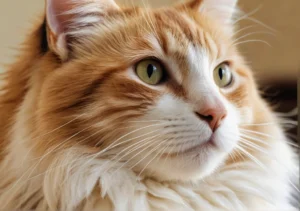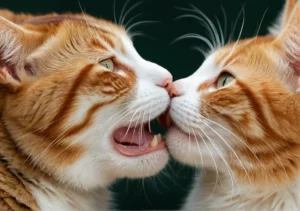Cats are charming companions that bring joy to our lives, but their tendency to bring up hairballs can be a messy and concerning issue for many pet owners. Understanding why cats bring up hairballs can help us better care for our feline friends and ensure their health and well-being.
Cats bring up hairballs as a way to rid their stomachs of indigestible hair that has accumulated from grooming. This natural behavior helps prevent blockages in their digestive tract and allows them to maintain their grooming routine.
What causes hairballs in cats?
Cats are meticulous groomers, constantly licking their fur to keep it clean and smooth. As they groom, they inevitably swallow loose hair, which can accumulate in their stomachs over time. This hair forms a ball-like mass that cannot be digested, leading to the formation of a hairball.
Other factors such as shedding, age, and breed can also contribute to hairball formation . Long-haired breeds, senior cats, and cats with skin conditions that cause excessive shedding are more prone to developing hairballs. Additionally, diet plays a significant role in hairball prevention. A lack of fiber in a cat’s diet can lead to poor digestion and increased hairball formation.
Regular grooming habits are crucial in preventing hairballs . Brushing your cat regularly can help remove loose hair before it is ingested. Ensuring your cat stays hydrated is also key, as adequate water intake can help move hair through the digestive system more effectively, reducing the likelihood of hairball formation.
For more information on grooming techniques and hairball prevention, check out this helpful resource from the American Association of Feline Practitioners: https://www.catvets.com/guidelines/practice-guidelines/grooming-and-nail-care.
How often should cats bring up hairballs?
It is normal for cats to bring up hairballs occasionally, as it is their natural way of expelling ingested fur. However, if you notice your cat bringing up hairballs more frequently than usual, it could indicate an underlying issue.
On average, most cats will bring up a hairball every 1-2 weeks . If your cat is bringing up hairballs more frequently than this, it may be worth consulting your veterinarian to rule out any health concerns. Excessive hairball formation can sometimes be a sign of an underlying gastrointestinal problem or other health issues.
To help reduce hairball frequency, incorporate special hairball control diets and treats into your cat’s feeding routine. These products are designed to help reduce hairball formation by aiding in digestion and preventing hairball accumulation.
Remember, every cat is unique, so what may be normal for one cat may not be normal for another. Monitoring your cat’s hairball frequency and behavior can help you determine what is regular for your feline friend and when it may be time to seek veterinary advice.
Are hairballs harmful to cats?
Hairballs can potentially pose risks to cats, especially if they occur frequently. When cats groom themselves, they ingest loose fur that can accumulate in their stomach. If this fur doesn’t pass through their digestive system and instead accumulates into a hairball, it can lead to blockages. These blockages can cause symptoms like gagging, retching, lack of appetite, constipation, or even more severe issues like intestinal obstruction.
To minimize the risks associated with hairballs, it’s crucial for cat owners to monitor their pets closely for any signs of distress or unusual behavior. Regular grooming to remove loose fur can help reduce the amount of hair ingested by the cat, lowering the chances of hairballs forming. Additionally, providing a balanced diet with plenty of fiber and hydration can aid in the natural passage of fur through the digestive tract, reducing the likelihood of hairball formation.
Lastly, if a cat frequently experiences hairballs or shows concerning symptoms, it’s essential to consult with a veterinarian for proper evaluation and treatment. Regular veterinary check-ups can help ensure that any potential issues are addressed promptly to keep your furry friend healthy and happy.
How can owners help prevent hairballs?
- Grooming: Regular brushing helps remove loose fur from your cat’s coat before they ingest it, reducing the amount of hair that ends up forming hairballs.
- Hydration: Ensure your cat has access to fresh water at all times to help the digestive system function properly and aid in the passage of hair through the gastrointestinal tract.
- Diet: Provide a balanced diet rich in fiber to promote healthy digestion and regular bowel movements, helping to prevent hairball formation.
- Hairball Remedies: Consider incorporating hairball prevention treats or supplements into your cat’s diet as recommended by your veterinarian.
- Environmental Enrichment: Encourage exercise and play to help keep your cat active, which can stimulate gut motility and reduce hairball formation.
By implementing these preventive measures, cat owners can significantly reduce the occurrence of hairballs and ensure their feline companions stay happy and healthy.
Should owners be concerned if their cat brings up frequent hairballs?
Frequent hairballs in cats can be a normal occurrence, especially in long-haired breeds. However, if your feline friend is producing an excessive amount of hairballs, it could indicate an underlying issue that requires veterinary attention. Keep a close eye on your cat’s grooming habits and hairball frequency. If you notice a sudden increase in hairballs, changes in appetite, or any other concerning symptoms, it’s best to schedule a visit to the vet. They can help rule out any potential health issues and provide the necessary treatment to keep your cat healthy and comfortable.
Are certain cat breeds more prone to hairballs?
Some cat breeds are more prone to developing hairballs due to their coat type or grooming habits. Breeds with long, thick fur like Persians, Maine Coons, and Ragdolls are more likely to experience hairball issues. Additionally, cats that groom themselves excessively are at a higher risk of ingesting more fur, leading to an increased chance of hairball formation. To help prevent hairballs in these breeds, regular grooming sessions to remove loose fur can significantly reduce the amount of hair your cat ingests. Consider speaking with your vet about specialized diets or supplements that can aid in hairball prevention for your specific breed.
Unique Insight: Essential Oils and Hairballs Prevention
Using essential oils like coconut oil or a special blend designed for cats can help promote good digestion and reduce hairball formation. When added to your cat’s food in small amounts as directed by your veterinarian, these oils can help lubricate the digestive tract and make it easier for hairballs to pass through naturally. Always ensure that any oils you use are safe for cats and consult with your vet before introducing them into your cat’s diet.
What are some natural remedies for hairballs in cats?
Hairballs in cats are a common issue that can be bothersome for both you and your feline friend. To help prevent and manage hairballs naturally, consider making some simple changes:
- Regular grooming: Brushing your cat frequently can help reduce the amount of loose fur they ingest while self-grooming.
- Dietary adjustments: Providing a high-fiber diet or adding a small amount of canned pumpkin to their food can aid in digestion and prevent hairballs.
- Water intake: Ensuring your cat stays hydrated can help their digestive system function properly and reduce hairball formation.
- Commercial remedies: Look for natural hairball control products containing ingredients like psyllium husk or slippery elm to help move hair through the digestive tract.
By incorporating these natural remedies into your cat’s routine, you can help minimize the frequency of hairball incidents and keep your furry companion happy and healthy.
For more detailed information on cat health and nutrition, you can check out the American Association of Feline Practitioners’ website.
Fun facts about cat hairballs
While hairballs may not be the most pleasant aspect of owning a cat, there are some interesting facts that may surprise you:
- Frequency: On average, a cat may experience hairballs once a week, with long-haired breeds more prone to this issue.
- Size: Hairballs can vary in size, from small, cylindrical shapes to larger, more oblong forms.
- Sound: The hacking sound a cat makes when trying to expel a hairball is caused by the irritation of the throat and esophagus.
- Self-cleaning: Cats groom themselves by licking their fur, but this can lead to the ingestion of loose hairs, contributing to hairball formation.
- Unique solutions: Some cat owners have reported success in reducing hairballs by incorporating a small amount of olive oil in their cat’s diet.
Understanding these fun facts can help you better comprehend why cats bring up hairballs and how you can help manage this common feline issue.
Alex, a passionate animal lover, has experience in training and understanding animal behavior. As a proud pet parent to two dogs and three cats, he founded AnimalReport.net to share insights from animal experts and expand his knowledge of the animal kingdom.




